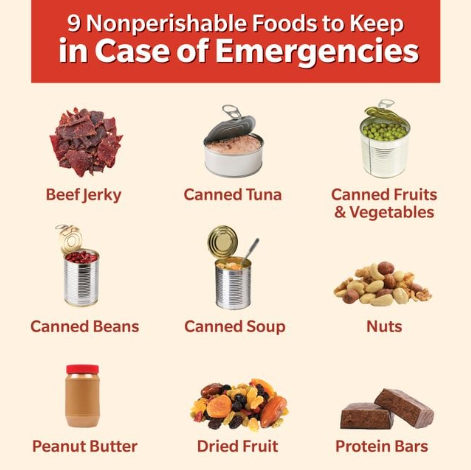BOURSESSENEGAL – When it comes to food storage, non-perishable food is a game changer. These items not only last for months, or even years, but they also provide convenience and peace of mind. Whether you’re preparing for emergencies, planning for a camping trip, or simply trying to save money, understanding how to choose and store non-perishable foods is essential. This guide will explore the benefits, types, and tips for stocking up on non-perishable food, ensuring you’re always ready for any situation.
What Is Non-Perishable Food?
Understanding Non-Perishable Items
Non-perishable food refers to products that do not require refrigeration and can withstand the test of time. These foods typically include canned goods, dried fruits, grains, and more. Their long shelf life makes them a staple in many households, especially in times of uncertainty or during natural disasters.
Why Choose Non-Perishable Food?
Choosing non-perishable food offers several benefits:
- Long Shelf Life: Most non-perishable foods can last months or even years without spoiling.
- Convenience: They are easy to store and require no special preparation.
- Cost-Effective: Buying in bulk can save money over time.
- Versatility: You can use non-perishable foods in a variety of recipes, making meal planning easier.
Types of Non-Perishable Food
Canned Goods
Canned foods are perhaps the most recognized non-perishable items. They include:
- Vegetables: Green beans, corn, and peas.
- Fruits: Peaches, pineapples, and pears.
- Soups and Stews: These can serve as complete meals.
- Protein: Tuna, chicken, and beans are excellent sources.
Dry Goods
Dry goods encompass a wide range of items, such as:
- Grains: Rice, pasta, and quinoa are staples in many diets.
- Legumes: Lentils, chickpeas, and dried beans are great for protein.
- Flours: Whole wheat, all-purpose, and gluten-free options.
Snacks and Sweets
Non-perishable snacks can keep you satisfied between meals. Options include:
- Nuts and Seeds: Almonds, walnuts, and sunflower seeds.
- Granola Bars: Convenient for on-the-go energy.
- Dried Fruits: Raisins, apricots, and cranberries.
Condiments and Cooking Essentials
Don’t forget about the essentials that can enhance your meals:
- Oils: Olive oil and vegetable oil.
- Spices and Seasonings: Salt, pepper, and dried herbs.
- Sauces: Soy sauce, ketchup, and hot sauce.
Tips for Stocking Non-Perishable Food
1. Assess Your Needs
Before you start stocking up, assess what you and your family eat regularly. This ensures you choose items you’ll actually use, reducing waste.
2. Choose Varied Options
Diversify your pantry with a range of non-perishable foods. This includes proteins, carbohydrates, and healthy fats. A varied diet keeps meals interesting and nutritious.
3. Pay Attention to Expiration Dates
Even non-perishable foods have a shelf life. Always check the expiration dates when purchasing. Rotate your stock by placing newer items behind older ones.
4. Store Properly
Store non-perishable foods in a cool, dry place. Avoid direct sunlight, which can affect quality. Organize your pantry so that you can easily see what you have.
5. Plan for Emergencies
Keep an emergency supply of non-perishable food on hand. Aim for at least a three-day supply per person. Consider high-calorie items that can sustain you in case of an emergency.
Cooking with Non-Perishable Food
Meal Ideas
Using non-perishable foods in your cooking can be delicious and fulfilling. Here are a few meal ideas:
Hearty Bean Chili
Ingredients:
- Canned beans (kidney, black, or pinto)
- Canned tomatoes
- Onion powder and garlic powder
- Chili powder
Instructions: Combine all ingredients in a pot, heat, and serve. This meal is not only easy but packed with protein and flavor.
Rice and Vegetable Stir-Fry
Ingredients:
- Instant rice
- Canned vegetables (like mixed vegetables or corn)
- Soy sauce
Instructions: Cook the rice according to package instructions, stir-fry with canned vegetables, and add soy sauce for taste. Quick and satisfying!
Snack Ideas
Non-perishable snacks can also be healthy and tasty:
- Nut Mix: Combine various nuts and seeds for a nutritious snack.
- Trail Mix: Mix dried fruits, nuts, and granola for a great on-the-go option.
- Popcorn: Air-popped popcorn is a healthy snack option that lasts long.
Common Myths About Non-Perishable Food
Myth 1: All Non-Perishable Foods Are Unhealthy
While some processed non-perishable foods can be high in sodium or sugar, many options are nutritious. Always read labels to make informed choices.
Myth 2: Non-Perishable Foods Taste Bad
Many non-perishable foods, especially canned and dried varieties, can taste delicious. With the right preparation and seasoning, they can be just as satisfying as fresh options.
Myth 3: Non-Perishable Means Indefinite
Even non-perishable foods have a shelf life. It’s crucial to monitor expiration dates and rotate your stock regularly.
Conclusion: Stock Up Wisely
Stocking up on non-perishable food is a smart and practical choice for any household. By understanding what types of foods to include, how to store them, and how to use them in your cooking, you can create a well-rounded pantry that meets your needs.
Whether for emergencies or everyday meals, non-perishable foods can provide peace of mind and convenience. Start assessing your pantry today and make sure you’re ready for whatever life throws your way.
Final Thoughts
Incorporate non-perishable foods into your diet and lifestyle for long-term benefits. With the right planning and preparation, you’ll never find yourself in a bind when it comes to meal options. Stock wisely, eat healthily, and enjoy the variety that non-perishable foods offer
REFERENCE : https://www.health.com/



